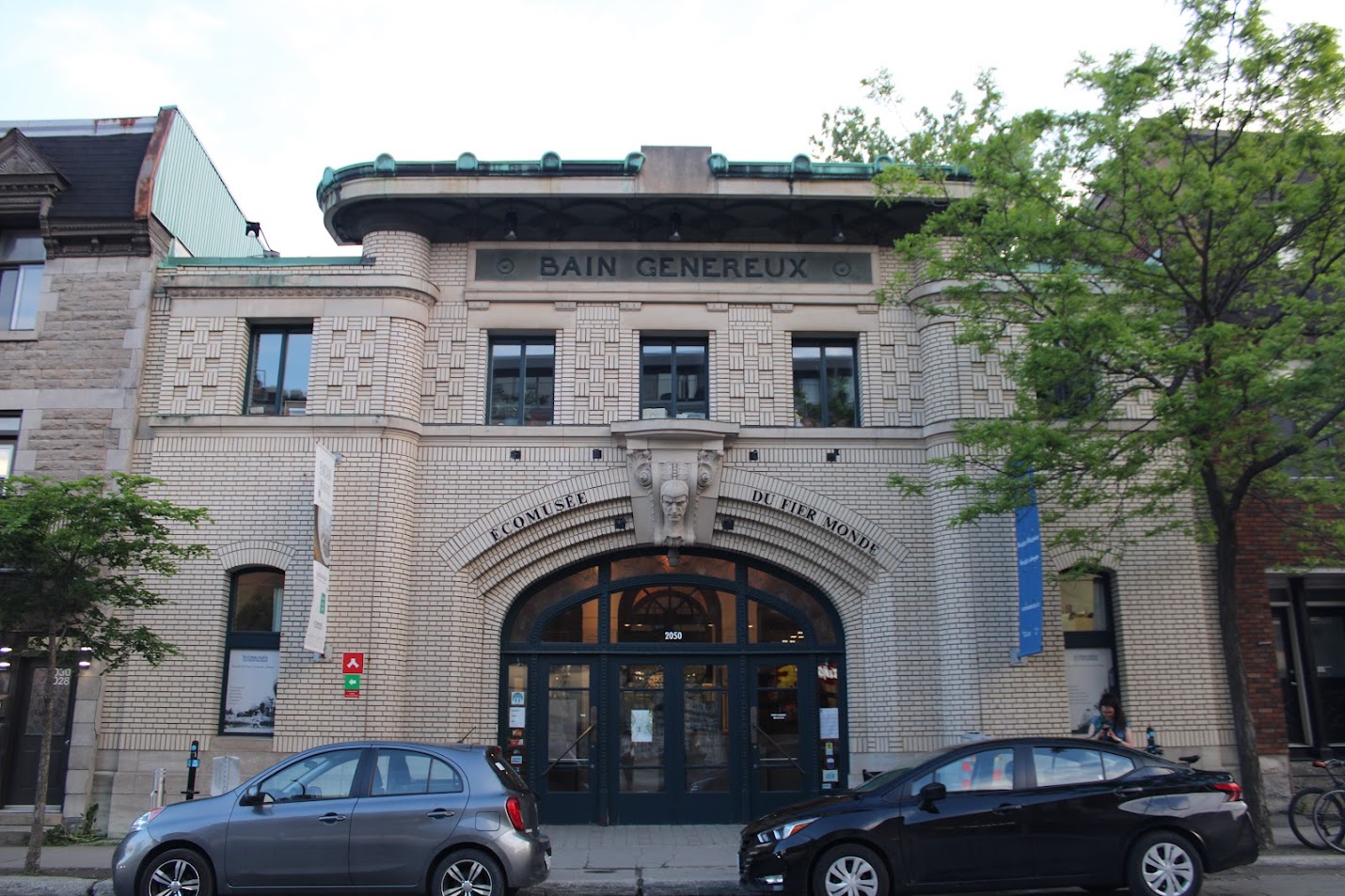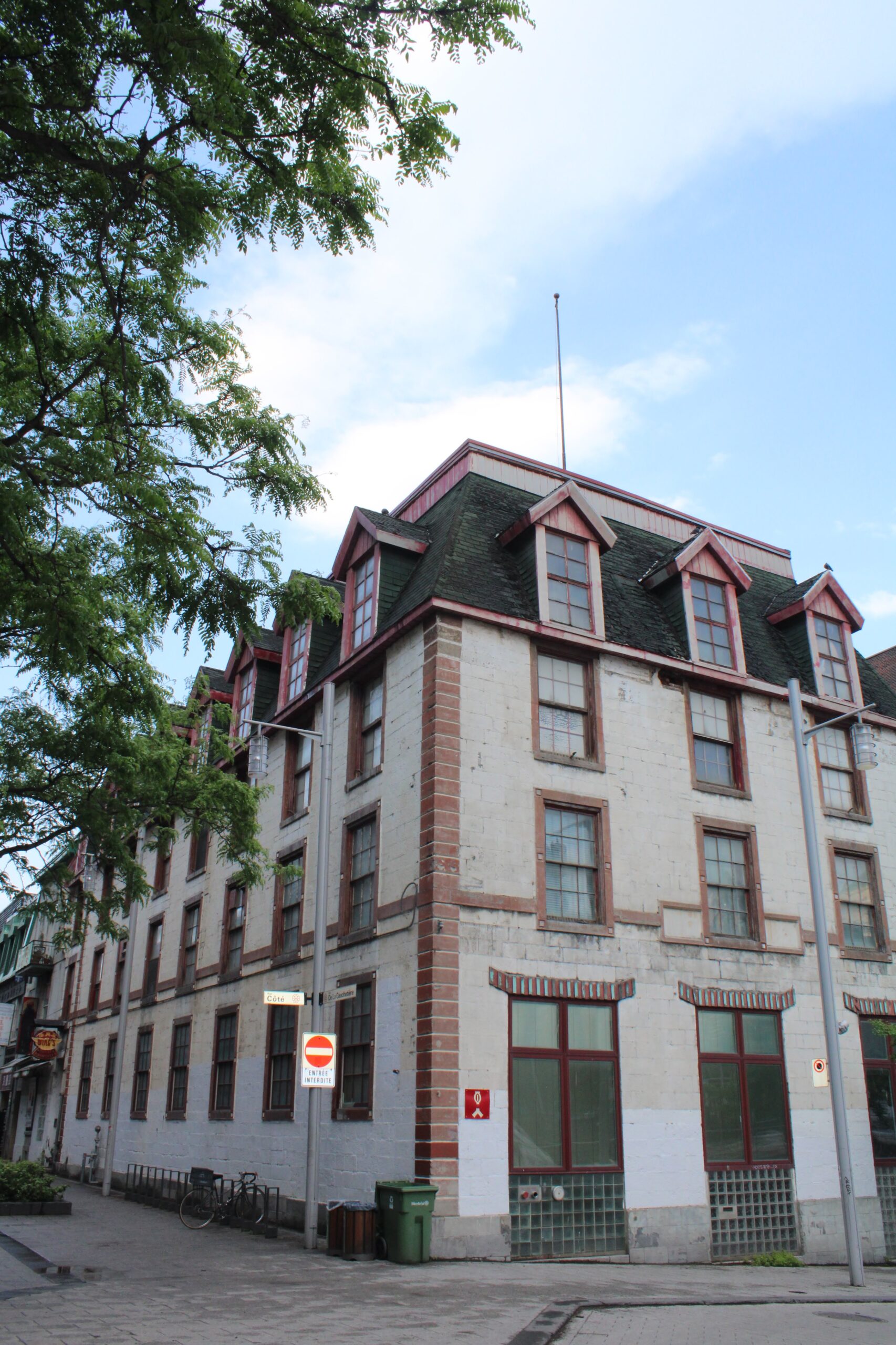Milk Bottles and Metro Signs: A Selection of Place-Based Histories in Montreal
Building Bridges, the National Trust-APT Joint Conference will be taking place in the city of Montréal, November 12-16, 2024. Settled on the traditional unceded territory of the Kanien’kehà:ka, the built landscape of the city evokes images of architectural icons like Safdie’s Habitat 67’, the lavish Victorian buildings of the Golden Square Mile, and the cobblestone roads of Montréal’s Old Port.
While these landmarks are no doubt worthy of the attention they are given, this article is not about them. Instead, this article outlines a few examples of everyday structures that illuminate some of the diverse histories of 20th-century Montréal: from swimming pools to movie theatres. By no means comprehensive, this exploration aims to uncover historical connections within corners of the city, both familiar and new.
Neighborhood Bathhouses
At the turn of the 20th century, Montréal’s working-class populations were facing a major health crisis. Large families lived in close quarters in densifying neighborhoods, with most houses lacking private bathing facilities.[i] According to the Ecomusée du Fier Monde, in a report from 1905, 75% of working-class neighborhoods lacked a bath or shower.[ii]
In response, between 1910-1930, the city funded the construction of bathhouses in working-class neighborhoods across the island. Many of these bathhouses also featured recreational swimming pools, and by the mid-twentieth century, as bathing facilities became a more common feature of working-class homes, these bathhouses evolved from a public health measure into aquatic facilities for sport and recreation.
A handful of these bathhouses are still open to the public as aquatic facilities today (7 to be exact) including Bain St. Denis (Constructed in 1910), Bain Émard (Constructed in 1914), and Bain Quintal (constructed in 1932).[iii]

The Bain Morgan opened in 1916 for the Mercier–Hochelaga-Maisonneuve bourough. The entrance features a bronze sculpture by Alfred La Liberté known as Les petits baigneurs. Over a hundred years old, Bain Morgan continues to operate as a public pool. Photo by Thomas1313 — Travail personnel, CC BY-SA 3.0

The Bain Généréux building was constructed in 1927 and operated as an aquatic facility until 1992. In 1996 the Ecomusée du Fier Monde converted the Bain Généréux into a museum space. Photo by author.
Guaranteed Pure Milk Ltd.
Symbols and signs of Montréal’s agri-food industry have become landmarks around the city and include the Farine Five Roses sign, the Gibeau Orange Julep, and the Molson Brewery.
A hidden favorite (especially in the last 3 years due to surrounding skyscraper development), is the Guaranteed Pure Milk Bottle Water Tower. This 6-tonne, 10-metre-high Milk bottle once served as both an advertisement for the Guaranteed Pure Milk Ltd. Company and a water tower for the companies’ pasteurization plant.

The Guaranteed Pure Milk Bottle as seen from Rue de La Montagne. Photo by author.
While Guaranteed Pure Milk Ltd. was founded in 1900, the plant and giant milk bottle weren’t created until the first years of the 1930s, around the time that pasteurization became mandatory for Dairy distributors in Montréal following a deadly typhoid outbreak in 1927 – attributed to the consumption of unpasteurized milk.[iv] According to Laiteries Du Quebec, Guaranteed Pure Milk’s water tower served as a publicity stunt to restore citizen’s faith in their product.[v]
In 1990, Guaranteed Pure Milk Ltd. was bought by Ault Foods, and the Giant Milk bottle was subsequently abandoned, falling into disrepair. However, thanks to the actions of invested citizens and the organizing power of Héritage Montréal in partnership with Quebec Federation of Milk Producers, the “Sauvons la Pinte” campaign was launched in 2009 resulting in a complete restoration of the water tower.
The milk bottle can be seen on the rooftop of 1025 Lucien Allier from Rue de la Montagne or Avenue Overdale.
The Entourage Guimard
The second oldest subway system in Canada, Montréal’s Metro was inaugurated on October 14, 1966. A defining feature of the metro system is the diverse architecture and public art installations that differ at each station. One of these is the Entourage Guimard, found at the Metro entrance in Square Victoria.
The entourage Guimard had its first life in Paris, France, and was designed by Hector Guimard, the architect commissioned to create the original entrances for the Paris Metro, between 1900-1913. Guimard’s designs fell out of fashion in the decades that followed, and many were dismantled and replaced with simpler marble designs.
In 1965, chief architect of the Montréal Metro, Pierre Bourgeau made an inquiry to the Parisian Autonomous Transport Administration (RATP) to have one of Guimard’s designs installed as part of the new Montréal Metro. The RATP, collaborators of Bourgeau in designing the Metro, had it installed in Square Victoria in 1967 on an “indefinite” loan.[vi] It is the only Guimard entrance found outside of Paris (although recreations are found around the world).

The Entourage Guimard is made of cast iron and features two “Lilly of the Valley” lamps. Photo by Author.
Wing Noodles Ltd.
Montréal’s Chinatown is an iconic part of the city’s downtown core. It is made up of some of the oldest buildings in the east of the Ville-Marie neighborhood yet are also some of the most endangered. Activist groups like the Jia Foundation have raised awareness of the threats facing the area from developers and gentrification and have united communities in safeguarding the districts’ living heritage.
In July 2023, the core of Montréal’s Chinatown was designated as a provincial heritage site, as well as two individual buildings within the district: the Former S. Davis and Sons cigar factory and the Wing Building. The Wing Building, originally built as an educational establishment in 1826, became an important site for manufacturing purposes to the burgeoning Chinese immigrant population settling in Chinatown in the late 19th century.[vii] By the 1960s, the building became home to Wing Noodles Ltd., the first producers of bilingual fortune cookies (French and English).[viii]

Wing Building. Photo by author.
Movie Theatres
The early twentieth century was a momentous time for cinema in Montréal. As Héritage Montréal writes, “at that time, there were 59 movie theatres in Montréal, each one bearing witness to the era through its architecture, both interior and exterior.” Many of these theatres are still open today, including the Théâtre Beanfield (built in 1912), the Imperial Theatre (1913) and the Theatre Outremount (1929).
One beloved example is the Cinema Beaubien. Known as Le Dauphin from 1964-2001, the cinema was built in 1937 and has been a long-regarded site to watch repertory, independent, and Quebec-made films. Purchased by Odeon in 1941, the cinema was under threat of closure when Odeon faced, and later filed for bankruptcy in 2001.
As scholars, Angulo, Tremblay and Klein wrote, the threat of Beaubien’s closure “meant the disappearance of a place of meeting, entertainment and leisure, which weakened the identity of the neighborhood and negatively affected the local commercial fabric.”[ix] The neighborhood rallied in support of the theatre, and thanks to local initiative, the Beaubien continues to serve as an important part of the social fabric of the Rosemont-La Petite-Patrie neighborhood today.

Photo: Cinéma Beaubien. Credit: J Boucher, CC BY-SA 4.0
Everyday edifices, from public transit to advertisement signs, can provide new insights into the social histories that have given shape to the city of Montréal. Interested in learning more, readers are encouraged to check out Héritage Montréal’s blog and their interactive map, Memento.
Registration for Building Bridges, the National Trust-APT Joint Conference 2024 opened in the Summer of 2024.
[i] Valerie Minnett and Mary-Anne Poutanen, “Swatting Flies for Health: Children and
Tuberculosis in Early Twentieth-Century Montreal,” Urban History Review /
Revue d’histoire urbaine 36, no. 1 (2007): 32, https://doi.org/10.7202/1015818ar.
[ii] Écomusée du fier monde, “GÉNÉRÉUX BATH,” Écomusée collections. https://ecomusee.qc.ca/en/collections/ecomusee-collections/the-genereux-bath/ .
[iii] Arrondissement du Sud-Ouest et Olivier Paré, “Le bain Émard.” Encyclopédie du MEM, November 7, 2017. https://ville.montreal.qc.ca/memoiresdesmontrealais/le-bain-emard.
[iv] Andy Riga. “1927 – the year Montreal milk made headlines and the city got a health code,” The Gazette. Article published February 14, 2011; Last edited July 12, 2020. https://montrealgazette.com/news/local-news/1927-the-year-montreal-milk-made-headlines-and-the-city-got-a-health-code.
[v] Laiteries Du Quebec, “The Guaranteed Pure Milk Co. Limited.” https://laiteriesduquebec.com/laiteries/mtl-guaranteed.htm.
[vi] Société de transport de Montréal, “Square-Victoria–OACI (Hector Guimard),”
https://www.stm.info/en/about/discover_the_stm_its_history/art-network/list-artworks/square-victoria-oaci-hector-guimard.
[vii] “Édifice de l’école-Britannique-et-Canadienne-de-Montréal.” Répertoire du patrimoine culturel du Québec. https://www.patrimoine-culturel.gouv.qc.ca/rpcq/detail.do?methode=consulter&id=117569&type=bien.
[viii] “History,” Wing Noodles Ltd, Accessed July 7, 2024. https://www.wingnoodles.com/en/history.php.
[ix] Wilfredo Angulo, Juan-Luis Klein, et Diane-Gabrielle Tremblay. Culture et Revitalisation Urbaine: Le Cas Du Cinéma Beaubien À Montréal, (Quebec: Presses de l’Universite du Quebec, 2022), 34.

